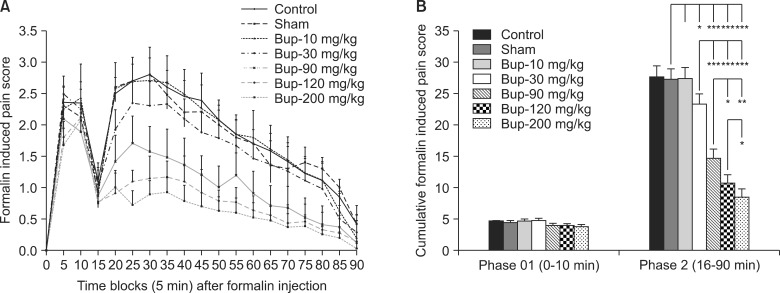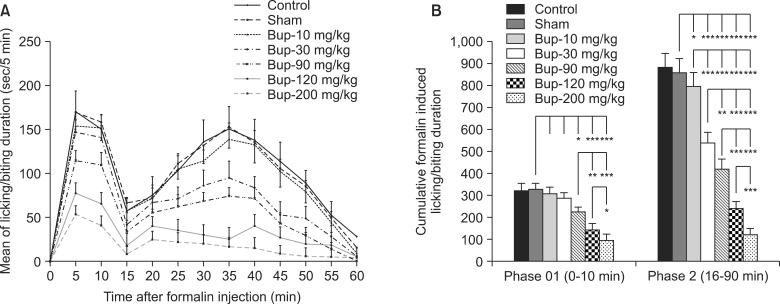Korean J Pain.
2014 Apr;27(2):118-124. 10.3344/kjp.2014.27.2.118.
Acute Systemic Infusion of Bupropion Decrease Formalin Induced Pain Behavior in Rat
- Affiliations
-
- 1Danesh Pey Hadi Co., Faculty of Medicine, Urmia University of Medical Sciences, Urmia, Iran.
- 2Neurophysiology Resaerch Center, Faculty of Medicine, Urmia University of Medical Sciences, Urmia, Iran. info@fgpakdel.com
- 3Department of Physiology, Faculty of Medicine, Urmia University of Medical Sciences, Urmia, Iran.
- 4Department of Histology & Embryology, School of Medicine, Dokuz EyluL University (DEU), Izmir, Turkey.
- KMID: 2074057
- DOI: http://doi.org/10.3344/kjp.2014.27.2.118
Abstract
- BACKGROUND
The chronic pain can disturb physical, psychological, and social performances. Analgesic agents are widely used but some antidepressants (ADs) showed analgesia also. Bupropion is using for smoke cessation but it can change morphine withdrawal signs such as pain. This study tested the acute systemic effect of bupropion on formalin induced pain behavior in rats.
METHODS
Wistar male healthy rats were divided into 7 groups (control, sham, and 5 treated groups with 10, 30, 90, 120, and 200 mg/kg of bupropion, i.p.). The bupropion injected 3 hours prior to formalin induced pain behavior. Formalin (50 microl, 2.5%) was injected subcutaneously in dorsal region of right hindpaw in all animals. Nociceptive signs were observed continuously on-line and off-line each minute. Common pain scoring was used for pain assessment.
RESULTS
The analysis of data by one-way ANOVA showed that bupropion can reduce pain scores in the second phase but not in first phase. Bupropion decreased the licking/biting duration significantly in first and second phase of formalin test.
CONCLUSIONS
The results showed that bupropion has analgesic effects at systemic application. The change of second phase of the pain behavior was significant and it revealed that central mechanisms involve in bupropion analgesia.
Keyword
MeSH Terms
Figure
Reference
-
1. Kang SS, Jung JW, Song CK, Yoon YJ, Shin KM. A new anterior approach for fluoroscopy-guided suprascapular nerve block - a preliminary report -. Korean J Pain. 2012; 25:168–172. PMID: 22787547.
Article2. Park HJ, Moon DE. Pharmacologic management of chronic pain. Korean J Pain. 2010; 23:99–108. PMID: 20556211.
Article3. Le Bars D, Gozariu M, Cadden SW. Acute pain measurement in animals. Part 1. Ann Fr Anesth Reanim. 2001; 20:347–365. PMID: 11392245.4. Dubuisson D, Dennis SG. The formalin test: a quantitative study of the analgesic effects of morphine, meperidine, and brain stem stimulation in rats and cats. Pain. 1977; 4:161–174. PMID: 564014.
Article5. Tjølsen A, Berge OG, Hunskaar S, Rosland JH, Hole K. The formalin test: an evaluation of the method. Pain. 1992; 51:5–17. PMID: 1454405.
Article6. Vaccarino AL, Chorney DA. Descending modulation of central neural plasticity in the formalin pain test. Brain Res. 1994; 666:104–108. PMID: 7889357.
Article7. Lebrun P, Manil J, Colin F. Formalin-induced central sensitization in the rat: somatosensory evoked potential data. Neurosci Lett. 2000; 283:113–116. PMID: 10739888.
Article8. Abbadie C, Taylor BK, Peterson MA, Basbaum AI. Differential contribution of the two phases of the formalin test to the pattern of c-fos expression in the rat spinal cord: studies with remifentanil and lidocaine. Pain. 1997; 69:101–110. PMID: 9060019.
Article9. Ascher JA, Cole JO, Colin JN, Feighner JP, Ferris RM, Fibiger HC, et al. Bupropion: a review of its mechanism of antidepressant activity. J Clin Psychiatry. 1995; 56:395–401. PMID: 7665537.10. Clayton AH. Extended-release bupropion: an antidepressant with a broad spectrum of therapeutic activity? Expert Opin Pharmacother. 2007; 8:457–466. PMID: 17309340.
Article11. Dwoskin LP, Rauhut AS, King-Pospisil KA, Bardo MT. Review of the pharmacology and clinical profile of bupropion, an antidepressant and tobacco use cessation agent. CNS Drug Rev. 2006; 12:178–207. PMID: 17227286.
Article12. Semenchuk MR, Sherman S, Davis B. Double-blind, randomized trial of bupropion SR for the treatment of neuropathic pain. Neurology. 2001; 57:1583–1588. PMID: 11706096.
Article13. El Mansari M, Ghanbari R, Janssen S, Blier P. Sustained administration of bupropion alters the neuronal activity of serotonin, norepinephrine but not dopamine neurons in the rat brain. Neuropharmacology. 2008; 55:1191–1198. PMID: 18708076.
Article14. Katz J, Pennella-Vaughan J, Hetzel RD, Kanazi GE, Dworkin RH. A randomized, placebo-controlled trial of bupropion sustained release in chronic low back pain. J Pain. 2005; 6:656–661. PMID: 16202958.
Article15. Semenchuk MR, Davis B. Efficacy of sustained-release bupropion in neuropathic pain: an open-label study. Clin J Pain. 2000; 16:6–11. PMID: 10741812.
Article16. Shah TH, Moradimehr A. Bupropion for the treatment of neuropathic pain. Am J Hosp Palliat Care. 2010; 27:333–336. PMID: 20185402.17. Ghaderi Pakdel F, Naderi S, Zare S. The opposite effect of intra-VTA bupropion on chewing and escape attendance behaviors of morphine withdrawal syndrome in rat. Urmia Med J. 2011; 21:415–422.18. Mokhtari Hashtjin M, Zare S, Ghaderi Pakdel F, Heysieattalab S. The effect of intra-VTA injection of Bupropion on submissive defensive aggressive behavior induced by electrical foot shock of rat. Pharm Sci. 2010; 16:125–130.19. Jahanbani M, Nasri S, Ghaderi Pakdel F, Cankurt U, Shahabi P, Amirabadi S, et al. The effect of acute intra Locus Coeruleus (LC) microinfusion of bupropion on formalin induced pain behavior in rat. Basic Clin Neurosci. 2014; 5:31–41.20. Fava M, Rush AJ, Thase ME, Clayton A, Stahl SM, Pradko JF, et al. 15 years of clinical experience with bupropion HCl: from bupropion to bupropion SR to bupropion XL. Prim Care Companion J Clin Psychiatry. 2005; 7:106–113. PMID: 16027765.21. Randrup A, Braestrup C. Uptake inhibition of biogenic amines by newer antidepressant drugs: relevance to the dopamine hypothesis of depression. Psychopharmacology (Berl). 1977; 53:309–314. PMID: 408861.
Article22. Sampson D, Willner P, Muscat R. Reversal of antidepressant action by dopamine antagonists in an animal model of depression. Psychopharmacology (Berl). 1991; 104:491–495. PMID: 1838201.
Article23. Thaler KJ, Morgan LC, Van Noord M, Gaynes BN, Hansen RA, Lux LJ, et al. Comparative effectiveness of second-generation antidepressants for accompanying anxiety, insomnia, and pain in depressed patients: a systematic review. Depress Anxiety. 2012; 29:495–505. PMID: 22553134.
Article24. Gallagher RM. Management of neuropathic pain: translating mechanistic advances and evidence-based research into clinical practice. Clin J Pain. 2006; 22:S2–S8. PMID: 16344609.25. Jackson KC 2nd, St Onge EL. Antidepressant pharmacotherapy: considerations for the pain clinician. Pain Pract. 2003; 3:135–143. PMID: 17163912.
Article26. Sharp J, Keefe B. Psychiatry in chronic pain: a review and update. Curr Psychiatry Rep. 2005; 7:213–219. PMID: 15935136.
Article27. Hawley P. Nontricyclic antidepressants for neuropathic pain #187. J Palliat Med. 2009; 12:476–477. PMID: 19416046.
Article28. Sansone RA, Sansone LA. Pain, pain, go away: antidepressants and pain management. Psychiatry (Edgmont). 2008; 5:16–19. PMID: 19724772.29. Miller A, Rabe-Jabłońska J. The effectiveness of antidepressants in the treatment of chronic non-cancer pain--a review. Psychiatr Pol. 2005; 39:21–32. PMID: 15771151.30. West CH, Ritchie JC, Boss-Williams KA, Weiss JM. Antidepressant drugs with differing pharmacological actions decrease activity of locus coeruleus neurons. Int J Neuropsychopharmacol. 2009; 12:627–641. PMID: 18950545.
Article31. Grant MM, Weiss JM. Effects of chronic antidepressant drug administration and electroconvulsive shock on locus coeruleus electrophysiologic activity. Biol Psychiatry. 2001; 49:117–129. PMID: 11164758.
Article32. Martin WJ, Gupta NK, Loo CM, Rohde DS, Basbaum AI. Differential effects of neurotoxic destruction of descending noradrenergic pathways on acute and persistent nociceptive processing. Pain. 1999; 80:57–65. PMID: 10204718.
Article33. Taylor BK, Roderick RE, Basbaum AI. Brainstem noradrenergic control of nociception is abnormal in the spontaneously hypertensive rat. Neurosci Lett. 2000; 291:139–142. PMID: 10984626.
Article34. Tsuruoka M, Matsutani K, Maeda M, Inoue T. Coeruleotrigeminal inhibition of nociceptive processing in the rat trigeminal subnucleus caudalis. Brain Res. 2003; 993:146–153. PMID: 14642840.
Article35. Tsuruoka M, Arai YC, Nomura H, Matsutani K, Willis WD. Unilateral hindpaw inflammation induces bilateral activation of the locus coeruleus and the nucleus subcoeruleus in the rat. Brain Res Bull. 2003; 61:117–123. PMID: 12831996.
Article36. Liu L, Tsuruoka M, Maeda M, Hayashi B, Inoue T. Coeruleospinal inhibition of visceral nociceptive processing in the rat spinal cord. Neurosci Lett. 2007; 426:139–144. PMID: 17913360.
Article37. Dong J, Blier P. Modification of norepinephrine and serotonin, but not dopamine, neuron firing by sustained bupropion treatment. Psychopharmacology (Berl). 2001; 155:52–57. PMID: 11374336.
Article38. Aston-Jones G, Bloom FE. Norepinephrine-containing locus coeruleus neurons in behaving rats exhibit pronounced responses to non-noxious environmental stimuli. J Neurosci. 1981; 1:887–900. PMID: 7346593.
Article39. Cedarbaum JM, Aghajanian GK. Activation of locus coeruleus neurons by peripheral stimuli: modulation by a collateral inhibitory mechanism. Life Sci. 1978; 23:1383–1392. PMID: 214648.
Article40. Hajós M, Engberg G, Elam M. Reduced responsiveness of locus coeruleus neurons to cutaneous thermal stimuli in capsaicin-treated rats. Neurosci Lett. 1986; 70:382–387. PMID: 3022199.
Article41. Chapman V, Suzuki R, Dickenson AH. Electrophysiological characterization of spinal neuronal response properties in anaesthetized rats after ligation of spinal nerves L5-L6. J Physiol. 1998; 507:881–894. PMID: 9508847.
Article42. Pertovaara A, Kontinen VK, Kalso EA. Chronic spinal nerve ligation induces changes in response characteristics of nociceptive spinal dorsal horn neurons and in their descending regulation originating in the periaqueductal gray in the rat. Exp Neurol. 1997; 147:428–436. PMID: 9344567.
Article43. Viisanen H, Pertovaara A. Influence of peripheral nerve injury on response properties of locus coeruleus neurons and coeruleospinal antinociception in the rat. Neuroscience. 2007; 146:1785–1794. PMID: 17445989.
Article44. Alba-Delgado C, Borges G, Sánchez-Blázquez P, Ortega JE, Horrillo I, Mico JA, et al. The function of alpha-2-adrenoceptors in the rat locus coeruleus is preserved in the chronic constriction injury model of neuropathic pain. Psychopharmacology (Berl). 2012; 221:53–65. PMID: 22038538.
Article45. Rosenberg MB, Carroll FI, Negus SS. Effects of monoamine reuptake inhibitors in assays of acute pain-stimulated and pain-depressed behavior in rats. J Pain. 2013; 14:246–259. PMID: 23332494.
Article46. Mico JA, Berrocoso E, Ortega-Alvaro A, Gibert-Rahola J, Rojas-Corrales MO. The role of 5-HT1A receptors in research strategy for extensive pain treatment. Curr Top Med Chem. 2006; 6:1997–2003. PMID: 17017970.
Article47. Campbell LC, Clauw DJ, Keefe FJ. Persistent pain and depression: a biopsychosocial perspective. Biol Psychiatry. 2003; 54:399–409. PMID: 12893114.
Article48. Amirabadi S, Ghaderi Pakdel F, Shahabi P, Naderi S. Microinfusion of bupropion inhibits putative GABAergic ventral tegmental area neuronal activity. Basic Clin Neurosci. 2014; [in press].
- Full Text Links
- Actions
-
Cited
- CITED
-
- Close
- Share
- Similar articles
-
- Antinociceptive Effects of Intraperitoneal and Intrathecal Vitamin E in the Rat Formalin Test
- Hypersexuality Induced by Combination of Bupropion and Clopidogrel
- Halothane effect on formalin-induced paw edema and flinching in rat
- Effect of Intrathecal Epigallocatechin-3-gallate on Formalin-induced Pain Rat Model
- Antinociceptive effects of vitamin E in formalin-induced nociceptive response in rats



